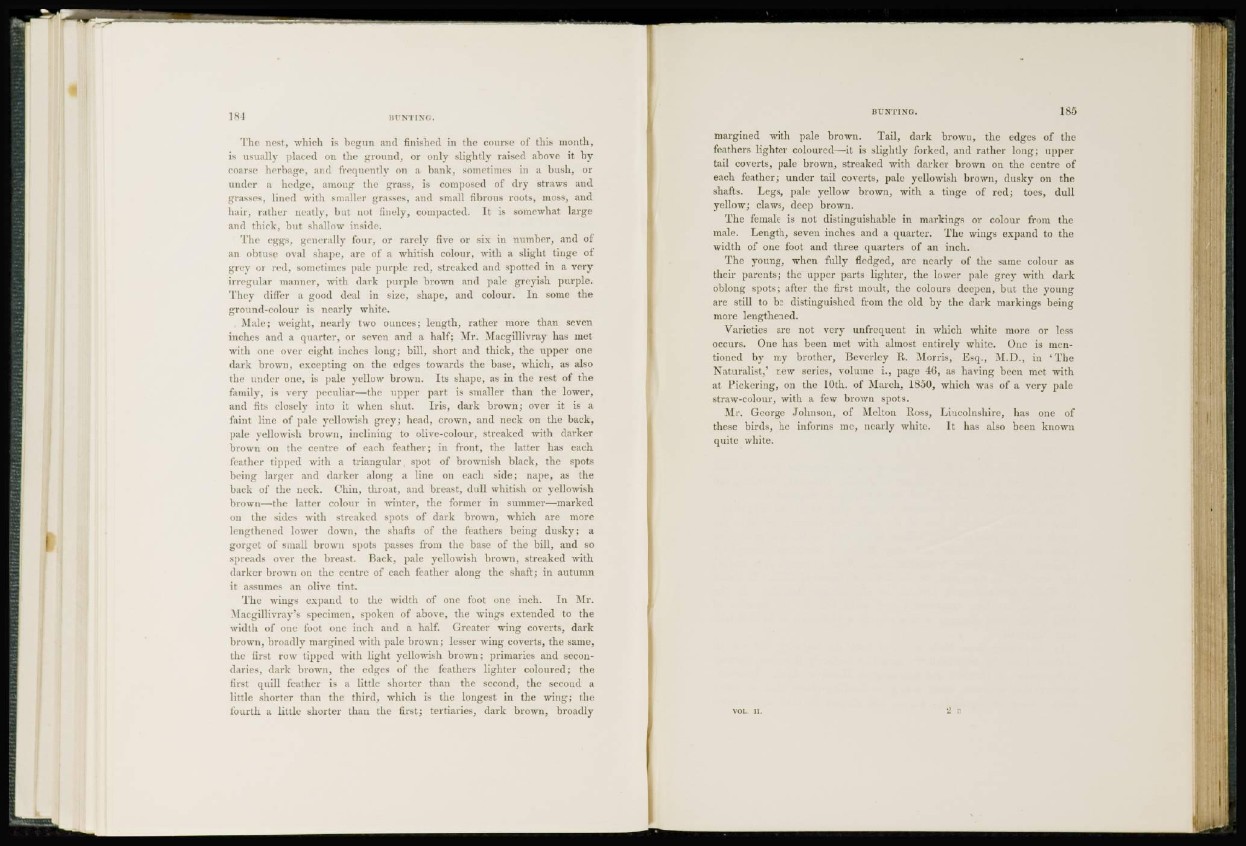
The nest, which is begun and finished in the course of this month,
is usually placed on the ground, or only slightly raised above it by
coarse herbage, and frequently on a bank, sometimes in a bush, or
under a hedge, among the grass, is composed of dry straws and
grasses, lined with smaller grasses, and small fibrous roots, moss, and
hair, rather neatly, but not finely, compacted. It is somewhat large
and thick, but shallow inside.
The eggs, generally four, or rarely five or six in number, and of
an obtuse oval shape, are of a whitish colour, with a slight tinge of
grey or red, sometimes pale purple red, streaked and spotted in a very
irregular manner, with dark purple brown and pale greyish purple.
They differ a good deal in size, shape, and colour. In some the
gron nd-colour is nearly white.
Male; weight, nearly two ounces; length, rather more than seven
inches and a quarter, or seven and a half; Mr. Macgillivray has met
with one over eight inches long; bill, short and thick, the upper one
dark brown, excepting on the edges towards the base, which, as also
the under one, is pale yellow brown. Its shape, as in the rest of the
family, is very peculiar—the upper part is smaller than the lower,
and fits closely into it when shut. Iris, dark brown; over it is a
faint line of pale yellowish grey; head, crown, and neck on the back,
pale yellowish brown, inclining to olive-colour, streaked with darker
brown on the centre of each feather; in front, the latter has each
feather tipped with a triangular spot of brownish black, the spots
being larger and darker along a line on each side; nape, as the
back of the neck. Chin, throat, and breast, dull whitish or yellowish
brown—the latter colour in winter, the former in summer—marked
on the sides with streaked spots of dark brown, which are more
Lengthened lower down, the shafts of the feathers being dusky; a
gorget of small brown spots passes from the base of the bill, and so
spreads over the breast. Back, pale yellowish brown, streaked with
darker brown on the centre of each feather along the shaft; in autumn
it assumes an olive tint.
The wings expand to the width of one foot one inch. In Mr.
Macgillivray's specimen, spoken of above, the wings extended to the
width of one foot one inch and a half. Greater wing coverts, dark
brown, broadly margined with pale brown; lesser wing coverts, the same,
the first row tipped with light yellowish brown; primaries and secondaries,
dark brown, the edges of the feathers lighter coloured; the
first quill feather is a little shorter than the second, the second a
little shorter than the third, which is the longest in the wing; the
fourth a little shorter than the first; tertiaries, dark brown, broadly
margined with pale brown. Tail, dark brown, the edges of the
feathers lighter coloured—it is slightly forked, and rather long; upper
tail coverts, pale brown, streaked with darker brown on the centre of
each feather; under tail coverts, pale yellowish brown, dusky on the
shafts. Legs, pale yellow brown, with a tinge of red; toes, dull
yellow; claws, deep brown.
The female is not distinguishable in markings or colour from the
male. Length, seven inches and a quarter. The wings expand to the
width of one foot and three quarters of an inch.
The young, when fully fledged, are nearly of the same colour as
their parents; the upper parts lighter, the lower pale grey with dark
oblong spots; after the Erst moult, the colours deepen, but the young
are still to be distinguished from the old by the dark markings being
more lengthened.
Varieties are not very unfrcqucnt in which white more or less
occurs. One has been met with almost entirely white. One is mentioned
by my brother, Beverley ft. Morris, Esq., M . D . , in ' The
Naturalist.,' new series, volume i., page 46, as having been met with
at Pickering, on the 10th. of March, 1850, which was of a very pale
straw-colour, with a few brown spots.
Mi-. George Johnson, of Melton Ross, Lincolnshire, has one of
these birds, he informs me, nearly white. It has also been known
quite white.
VOL. II.